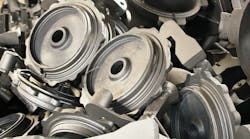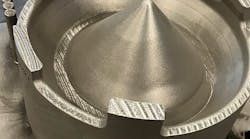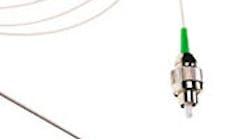Chiral Photonics — a company that aims “to create the next generation of photonic solutions” — has developed a sensor technology that one day soon may be useful in metalcasting applications, such as for monitoring temperatures in induction melting furnaces.
As its core technology, Chiral Photonics is working to advance a 1997 discovery by two of its founders, physicists Azriel Genack and Victor Kopp of City University of New York: that is, that a helical microstructure in glass fibers is highly advantageous for producing lasing. Their insight has already translated into some glass fiber-based products, for instance, polarizers, couplers, and sensors, including an ultra-high temperature sensing element, which can operate at 1000+°C, three times as high as the current state-of-the-art at 325°C.
While thermocouples can go up to and even over 1,000°C, they may encounter difficulties with lifetime, drift, response time, and electromagnetic interference (EMI)/noise. Fiberoptic sensors have similar trouble over 325°C, as a result of washed out gratings. Thus, manufacturers using processes operating at greater than 325°C find themselves having to, at intervals as often as daily, shut down production runs entirely in order to replace expired thermocouples. This approach involves the direct and recurring expense of the thermocouples, plus the indirect expense of lost production.
Chiral Photonics sensing elements, while preserving the advantages of fiber-optic sensors in general, do not rely on photosensitive glasses. Rather, the sensors are microformed into the fiber and, therefore, can be fabricated in glasses ideal for specific applications. For instance a sensor element can be made that can resist electromagnetism, radiation, chemical corrosiveness, and temperature. Because the sensing elements are made of fiber they avoid all these problems entirely, and are as rugged and durable as the fiber itself. In addition, they are in a flexible form factor, lightweight, and highly accurate.
“We do not have induction furnace data to share at present,” Chiral’s Saul Felman reports, “but we do have some customers starting to use our fiber sensors for such measurements because fiber sensors in general have no susceptibility to EMI and have fast response times, and these in particular have much higher temperature operating ranges than conventional fiber-optic sensors.” For induction furnace operators there will be an additional interest in non-metal sensors that can accurately gauge the temperature of the environment without preferentially heating up themselves.
Felman notes, “Although our fiber sensors are often delivered with a metal sheathing for many industrial applications, in essence they are all glass and can be delivered as such, as per the preference of the customer.”
An infrared camera needs line-of-sight access as the camera itself cannot withstand high temperatures, and that is limiting factor.
According to Felman, “Our understanding is that while infra-red sensing can be used for visible portions of an induction furnace, the temperature in hidden spots can not be easily sensed. Also, with induction furnaces thermocouples give inaccurate readings as they absorb a disproportionate amount of the induction.
“All fiber sensors are EMI- or induction resistant,” Felman continues. “However, no other fiber sensor goes higher than approximately 325°C before its UV-written gratings wash out. In contrast, our sensors are fabricated into the glass so that they are as resistant as the glass itself.
“We have over 2,000 hours cycling between 700ºC and 1,000ºC, at 55 hours per cycle,” he concludes. “In addition, we have had excursions to 1,200ºC also with no stability degradation.”











